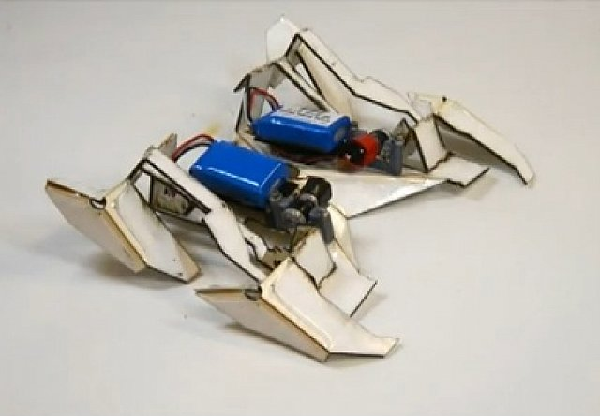"Folding Satellites" Move Closer to Reality with Transformable Robots
| Paula Marie Navarra | | Aug 09, 2014 11:51 PM EDT |
The first transformable or folding robot made from paper
The recent success achieved by U.S. researchers in crafting the world's first folding or transformable robot opens the door to a wide array of future applications.
One of these is a "folding satellite" that could be launched into orbit as flat panels that transform into a satellite in orbit.
Like Us on Facebook
Engineers now have the experience to build satellites that can assemble themselves once they're in space, believes Sam Felton, one the Harvard engineers that made the transformer robot made from paper.
Only this week, researchers Harvard and the Massachusetts Institute of Technology invented the first functioning "transformer robot" made from a sheet of paper and plastic scraps.
Using the Japanese paper-folding art origami, a team of engineers and researchers created the first robot that can fold itself into arbitrary shapes without any intervention from a human operator.
As soon as batteries were attached to the robot, the flat sheet of paper transformed into a complex machine with four legs and started crawling away in a span of just four minutes.
Engineers draw their inspiration in building this transformer robot from nature and its ability to assemble itself, like the way linear sequences in amino acids fold into complex proteins.
Rob Wood from Harvard said that getting a robot assemble itself and function properly is a milestone engineers have been chasing for many years.
The origami or transformer-like robot had a full electromechanical system embedded into a flat paper sheet. The electromechanical system consisted of two motors, two batteries and a microcontroller served as the robot's brain
The transformer-like robot had a timer that activated after 10 seconds.
Felton said that modifications to the triggers could be made to improve the design. Triggers activated by environmental factors such as temperature and pressure could be made to fold a robot.
Despite this success, Felton admitted that one of the primary challenges in the process was the propensity of the robots to burn up before folding properly.
He believes researchers can improve the robot based on the first transformable robot they built. Researchers plan to experiment on different kinds of polymers that are stronger and better able to withstand heat.
©2015 Chinatopix All rights reserved. Do not reproduce without permission
EDITOR'S PICKS
-

Did the Trump administration just announce plans for a trade war with ‘hostile’ China and Russia?
-

US Senate passes Taiwan travel bill slammed by China
-

As Yan Sihong’s family grieves, here are other Chinese students who went missing abroad. Some have never been found
-

Beijing blasts Western critics who ‘smear China’ with the term sharp power
-

China Envoy Seeks to Defuse Tensions With U.S. as a Trade War Brews
-

Singapore's Deputy PM Provides Bitcoin Vote of Confidence Amid China's Blanket Bans
-

China warns investors over risks in overseas virtual currency trading
-

Chinese government most trustworthy: survey
-

Kashima Antlers On Course For Back-To-Back Titles
MOST POPULAR
LATEST NEWS
Zhou Yongkang: China's Former Security Chief Sentenced to Life in Prison

China's former Chief of the Ministry of Public Security, Zhou Yongkang, has been given a life sentence after he was found guilty of abusing his office, bribery and deliberately ... Full Article
TRENDING STORY

China Pork Prices Expected to Stabilize As The Supplies Recover

Elephone P9000 Smartphone is now on Sale on Amazon India

There's a Big Chance Cliffhangers Won't Still Be Resolved When Grey's Anatomy Season 13 Returns

Supreme Court Ruled on Samsung vs Apple Dispute for Patent Infringement

Microsoft Surface Pro 5 Rumors and Release Date: What is the Latest?










